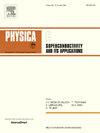掺杂对电子掺杂铁锑化物超导体中自旋密度波和超导性的影响
IF 1
3区 物理与天体物理
Q4 PHYSICS, APPLIED
Physica C-superconductivity and Its Applications
Pub Date : 2025-04-11
DOI:10.1016/j.physc.2025.1354705
引用次数: 0
摘要
我们建立了一个哈密顿模型来研究掺杂对电子掺杂铁离子超导体的超导性和自旋密度波的影响。该模型基于BCS机制,采用平均场方法。由Zubarev型电子格林函数导出了单粒子电子格林函数的运动方程。通过对准粒子能量的分析,导出了单粒子相关函数。对不同掺杂浓度下的超导(SC)隙(z)、自旋密度波(SDW)隙(h)和化学势(μ)进行了自一致的数值计算。结果表明,随着掺杂水平的增加,SDW逐渐减弱,导致超导的发生。在掺杂x=0.045 ~ 0.06范围内,SDW与超导性共存。进一步掺杂导致自旋密度波受到抑制,同时超导临界温度升高,在x=0.07时达到26 K。描述SDW Neel温度、SC临界温度与掺杂参数关系的相图与实验结果吻合较好。本文章由计算机程序翻译,如有差异,请以英文原文为准。
Effect of doping on spin density wave & superconductivity in electron-doped iron Pnictide superconductors
We formulate a Hamiltonian model to investigate the effects of doping on superconductivity and spin density wave in electron-doped iron pnictide superconductors. The model, which is based on the BCS mechanism, employs a mean-field approach. The equations of motion for single-particle electron Green’s functions are derived from Zubarev type electron Green’s function. Single-particle correlation functions were derived by analysing the quasi-particle energies. The superconducting (SC) gap (z), spin density wave (SDW) gap (h) and chemical potential () were determined self-consistently and numerically for various dopant concentrations (x). The results indicate that as doping levels increase, the SDW gradually weakens, leading to the onset of superconductivity. In the doping range , a coexistence of the SDW and superconductivity is observed. Further doping results in the suppression of the spin density wave, accompanied by a rise in the superconducting critical temperature, which reach 26 K at . The phase diagram depicting the relationship between the SDW Neel Temperature, SC critical temperature and doping parameter agrees well with experimental observations.
求助全文
通过发布文献求助,成功后即可免费获取论文全文。
去求助
来源期刊
CiteScore
2.70
自引率
11.80%
发文量
102
审稿时长
66 days
期刊介绍:
Physica C (Superconductivity and its Applications) publishes peer-reviewed papers on novel developments in the field of superconductivity. Topics include discovery of new superconducting materials and elucidation of their mechanisms, physics of vortex matter, enhancement of critical properties of superconductors, identification of novel properties and processing methods that improve their performance and promote new routes to applications of superconductivity.
The main goal of the journal is to publish:
1. Papers that substantially increase the understanding of the fundamental aspects and mechanisms of superconductivity and vortex matter through theoretical and experimental methods.
2. Papers that report on novel physical properties and processing of materials that substantially enhance their critical performance.
3. Papers that promote new or improved routes to applications of superconductivity and/or superconducting materials, and proof-of-concept novel proto-type superconducting devices.
The editors of the journal will select papers that are well written and based on thorough research that provide truly novel insights.

 求助内容:
求助内容: 应助结果提醒方式:
应助结果提醒方式:


